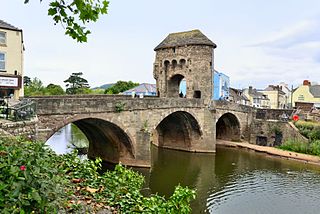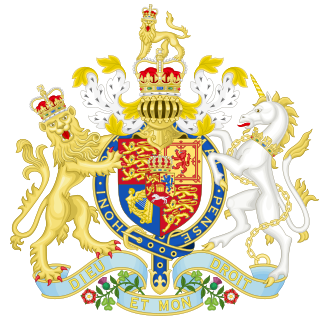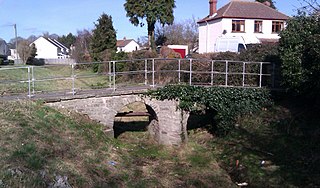
Monmouth is a market town and community in Monmouthshire, Wales, situated on where the River Monnow joins the River Wye, two miles from the Wales–England border. The population in the 2011 census was 10,508, rising from 8,877 in 2001. Monmouth was the county town of historic Monmouthshire, although Abergavenny is the largest settlement and Monmouthshire County Council has its main offices at Rhadyr, just outside Usk. Monmouth is in the UK Parliament constituency of Monmouthshire and the Senedd constituency of Monmouth.

Monmouthshire is a county in the south east of Wales. It borders Powys to the north; the English counties of Herefordshire and Gloucestershire to the north and east; the Severn Estuary to the south, and Torfaen, Newport and Blaenau Gwent to the west. The largest town is Abergavenny, and the administrative centre is Usk.

The Royal Monmouthshire Royal Engineers (Militia) is the most senior regiment of the British Army Reserve. The regiment was formed in 1539 during the reign of by King Henry VIII. The R Mon RE (M) became a militia unit in 1660 and then became a part of the Royal Engineers in 1877.

Monmouth School for Boys was a public school for boys in Monmouth, Wales. The school was founded in 1614 with a bequest from William Jones, a successful merchant and trader. The school is run as a trust, the William Jones's Schools Foundation, by the Worshipful Company of Haberdashers, one of the livery companies, and has close links to its sister school, Haberdashers' Monmouth School for Girls. In 2018, the Haberdashers renamed their group of schools in the town, the Monmouth Schools, and made corresponding changes to the names of the boys' and girls' schools. Further changes were initiated in June 2022, when the Haberdashers opened a consultation on merging the school with the girls school in the town to create a fully coeducational establishment. In October 2024 the amalgamated schools were relaunched as Haberdashers' Monmouth School.

The Pilkington, later Milborne-Swinnerton-Pilkington Baronetcy, of Stanley in the County of York, is a title in the Baronetage of Nova Scotia. It was created on 29 June 1635 for Arthur Pilkington, along with a grant of 6,000 acres (24 km2) in Nova Scotia. The fifth Baronet was High Sheriff of Yorkshire for 1740–41 and sat as member of parliament for Horsham.
This is a list of Sheriffs of Monmouthshire, an office which was created in 1536 but not fully settled until 1540.

St Mary's Priory Church, in Whitecross Street, Monmouth, Monmouthshire, Wales, is an Anglican church founded as a Benedictine priory in 1075. The current church dates mostly from the 18th and 19th centuries. It was designated a Grade II* listed building in 1952. It is one of 24 buildings on the Monmouth Heritage Trail.

Cornwall House is a town house located at numbers 56 and 58, Monnow Street in Monmouth, Wales. It dates in part from the 17th century but was rebuilt in several stages later. The street facade and rear facade are very different, but both are reworkings of a much older building. It is a Grade II* listed building, and has been described in The Buildings of Wales as "the most imposing house in the street". Part has been the main office of the Monmouthshire Beacon newspaper since 1987.

Treowen is an early 17th-century house in Monmouthshire, Wales, regarded as "the most important gentry house in the county". It is located in open countryside within the parish of Wonastow, about ½ mile (1 km) north-east of the village of Dingestow, and 3 miles (4.8 km) south-west of Monmouth. After being used as a farmhouse for three centuries, Treowen now operates as a conference and functions venue and holds the annual Wye Valley Chamber Music Festival. It is a Grade I listed building, and its gardens are designated Grade II on the Cadw/ICOMOS Register of Parks and Gardens of Special Historic Interest in Wales.

Monmouth Poor Law Union was formed on 11 July 1836 in Monmouth, Wales
Henry Milbourne, also Milburne or Milborne, was a Welsh magistrate who served as the Recorder of Monmouth and as agent to the Duke of Beaufort.
John Arnold, widely known as John Arnold of Monmouthshire, was an English Protestant politician and Whig MP. He was one of the most prominent people in the Welsh county of Monmouthshire in the late 17th century. A stark anti-Catholic, he was a notable figure during the Popish plot and the suppression of Catholicism in the country. Arnold represented the constituencies around Monmouth and Southwark in Parliament in the 1680s and 1690s. His strong anti-Catholic beliefs and insurgences against Catholic priests made him an unpopular and controversial figure amongst his peers and in his native Monmouthshire. In his later years, his behaviour became increasingly eccentric, and he was widely believed to have faked an attempt on his own life. Amongst his associates were Titus Oates and Anthony Ashley Cooper, 1st Earl of Shaftesbury.

The Clawdd-du, also known in historical records as the Black Dyke, Black Ditch or Clawthy, is a mediaeval linear defensive earthwork or moat, constructed as protection for the faubourg of Overmonnow, on the opposite side of the River Monnow from the town and castle of Monmouth, Wales.

Wonastow Court, in Wonastow, Monmouthshire, Wales, is a 19th-century country house with earlier origins and later additions. The court is a Grade II listed building, and its gardens are listed, also at Grade II, on the Cadw/ICOMOS Register of Parks and Gardens of Special Historic Interest in Wales.
William Milborne was an English landowner and politician who sat in the House of Commons in 1660.

Hadnock is an area of farmland and woodland in Monmouthshire, Wales, 1.5 miles (2.4 km) north-east of Monmouth, on the east bank of the River Wye adjoining the border with England. It is located in the parish of Dixton, in the ancient manor of Hadnock, and is accessed from the road between Wyesham and Staunton. The area is thinly populated. The main properties are Hadnock Court House, a Grade II listed building originating in the 17th century, and Little Hadnock, a small hamlet which is located a few hundred yards to the north-east.

Kingsley House and Hendre House are a pair of 19th-century, semi-detached houses on the North Parade section of Monk Street in Monmouth, Monmouthshire, Wales. The grade II listed houses were designed by noted Monmouth architect and builder George Vaughan Maddox, who also designed at least two of the twenty-four blue plaque buildings on the Monmouth Heritage Trail, including the Market Hall and the Monmouth Methodist Church. Hendre House should be distinguished from The Hendre, the estate of the Rolls family.

St James House is a grade II listed building in Monmouth, Monmouthshire, Wales. It is in the historic St James Square neighbourhood, within the Medieval town walls. While the house currently has an attractive, 18th-century facade, it originated as a burgage tenement. In addition, behind the house, evidence of a kiln has been unearthed, with both Medieval and Post-medieval pottery. In 2010, archaeological excavation in the square revealed the first evidence of Mesolithic human settlement in Monmouth. Recent residents of St James House have included boarding students from Monmouth School.

The Monmouth Police Station is a Grade II listed building in the town centre of Monmouth, Monmouthshire, Wales. It is located in Glendower Street, within the medieval town walls. In March 2012, it was announced that the Monmouth Police Station was one of seventeen police stations in South East Wales that would no longer be open to the public.

Perth-hir House, Rockfield, Monmouthshire, Wales, was a major residence of the Herbert family. It stood at a bend of the River Monnow, to the north-west of the village. At its height in the 16th century, the mansion, entered by two drawbridges over a moat, comprised a great hall and a number of secondary structures. Subsequently in the ownership of the Powells, and then the Lorimers, the house became a centre of Catholic recusancy following the English Reformation. By the 19th century, the house had declined to the status of a farmhouse and it was largely demolished in around 1830. Its ruins, and the site which contains considerable remnants of a Tudor garden, are a scheduled monument.


















